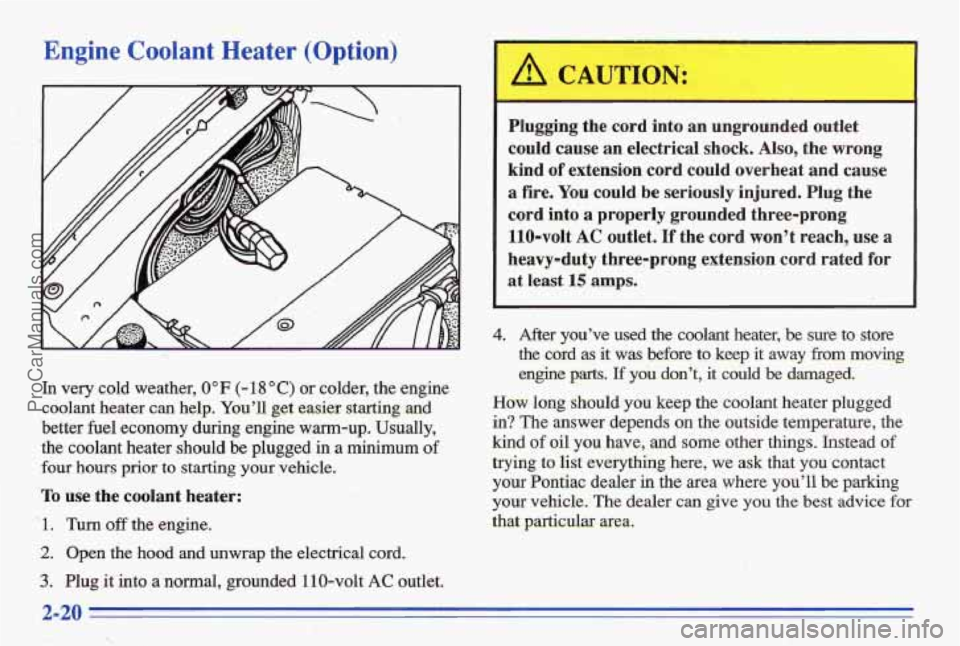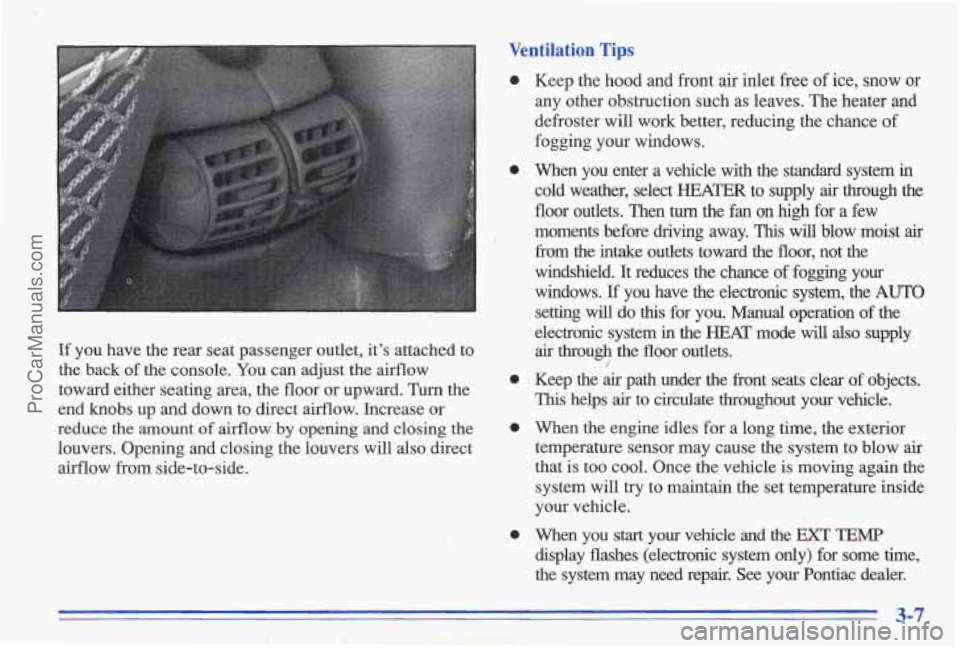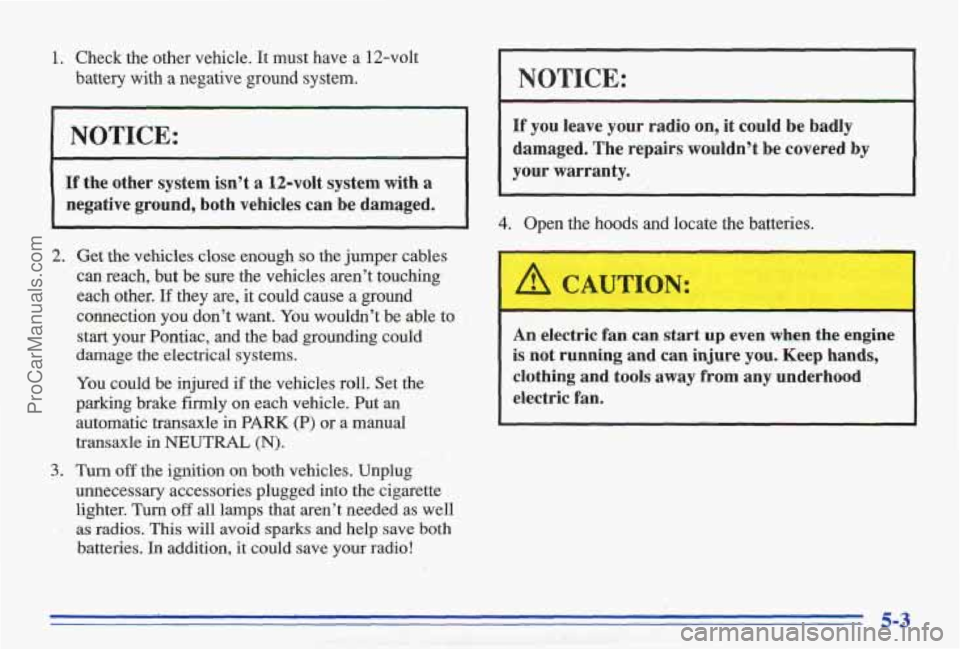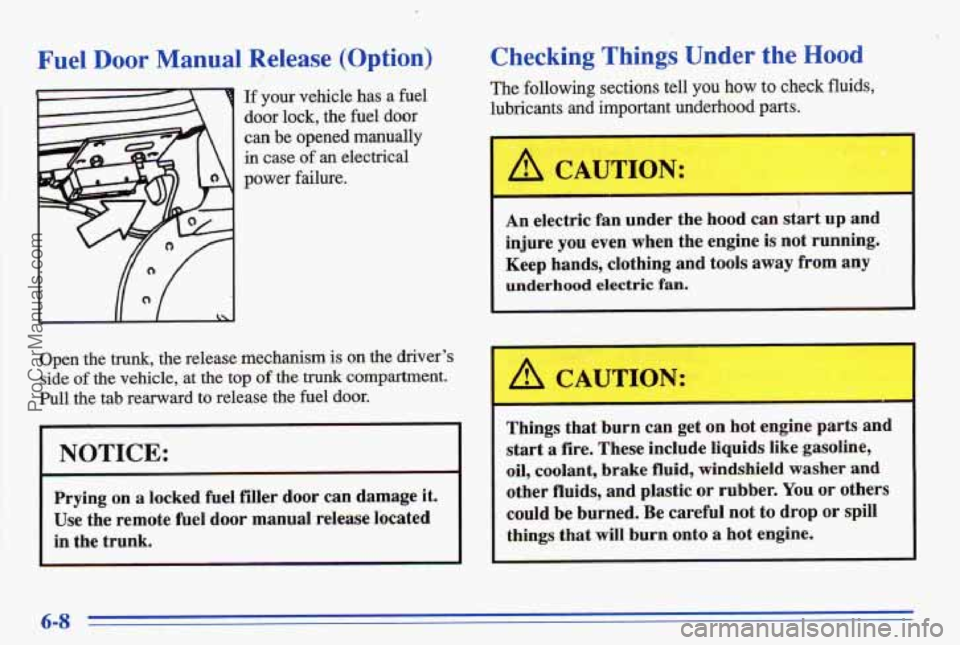Page 71 of 387

Engine CoolantKeater (Option)
In very cold weather, 0" F (- 18 O C) or colder, the engine
coolant heater
can help. You'll get easier starting and
better fuel economy during engine warm-up. Usually,
the coolant heater should
be plugged in a minimum of
four hours prior to starting you vehicle.
To use the coolant heater:
'' 1. Turn off the engine.
2. Open the hood and unwrap the electrical cord.
3. Plug it into a normal, grounded 1 10-volt AC outlet.
A. CAUTION:
Plugging the cord into an ungrounded outlet
could cause an electrical shock.
Also, the wrong
kind
of extension cord could overheat and cause
a fire. You could be seriously injured. Plug the
cord into
a properly grounded three-prong
110-volt
AC outlet. If the cord won't reach, use a
heavy-duty three-prong extension cord rated for
at least 15 amps.
,
4. After you've used the coolant heater? be sure to store
the cord as it was before to keep it away fiom moving
engine parts.
If you don't, it could be damaged.
How long should YQU keep the coolant heater plugged
in? The answer depends on the outside temperature, the
kind of oil you have, and some other things. Instead of
trying to list everything here, we ask that you contact
your Pontkc dealer
in the area where you'll be parking
your vehicle. The dealer can give you the best advice for
that particular mea.
ProCarManuals.com
Page 144 of 387

If you have the rear seat passenger outlet, it's attached to
the back
of the console. You can adjust the airflow
toward either seating area, the floor or upward. Turn the
end
knobs up and down to direct airflow. Increase or
reduce
the amount of airflow by opening and closing the
louvers. Opening and closing the louvers will also direct airflow from side-to-side.
Ventilation Tips
0 Keep the hood and front air inlet free of ice, snow or
any other obstruction such as leaves. The heater and
defroster will work better, reducing the chance of
fogging your windows.
0 When you enter a vehicle with the standard system in
cold weather, select
HEATER to supply air through the
floor outlets. Then
turn the fan on high for a few
moments before driving away. This will blow moist air
from the intake outlets toward the floor, not the
windshield. It reduces
the chance of fogging your
windows. If you have the electronic system, the AUTO
setting will do this for you. Manual operation of the
electronic system in the
HEAT' mode will also supply
air through the floor outlets.
0 Keep the air path under the front seats clear of objects.
This helps air to circulate throughout your vehicle.
0 When the engine idles for a long time, the exterior
temperature sensor may cause the system to blow
air
that is too cool. Once the vehicle is moving again the
system will
try to maintain the set temperature inside
your vehicle.
display flashes (electronic system only) for some time,
the system may need repair. See
your Pontiac dealer.
/
0 When you start your vehicle and the EXT TEMP
ProCarManuals.com
Page 208 of 387

1. Check the other vehicle. It must have a 12-volt
battery with
a negative ground system.
NOTICE:
If the other system isn’t a 12-volt system with a
negative ground, both vehicles can be damaged.
2. Get the vehicles close enough so the jumper cables
can reach, but be sure the vehicles aren’t touching-
each other.
If they are, it could cause a ground
connection you don’t want. You wouldn’t be able
to
start your Pontiac, and the bad grounding could
damage the electrical systems.
You could be injured
if the vehicles roll. Set the
parking brake firmly on each vehicle. Put an
automatic transaxle in PARK (P) or a manual
transaxle
in NEUTRAL (N).
3. Turn off the ignition on both vehicles. Unplug
unnecessary accessories plugged into the cigarette
lighter. Turn
off all lamps that aren’t needed as well
I as radios. This will avoid sparks and help save both
batteries. In addition, it could save your radio!
NOTICE:
If you leave your radio on, it could be badly
damaged.
The repairs wouldn’t be covered by
your warranty.
4. Open the hoods and locate the batteries.
An electric fan can start ~ even wl 3 the engine
is not running and can injure you. Keep hands,
clothing and tools away
from any underhood
electric fan.
5-3
ProCarManuals.com
Page 220 of 387
Engine Overheating
You will find a coolant temperature gage or the warning
light about a hot engine
on your Pontiac’s instrument
panel. See “Coolant Temperature Gage” and “Coolant Temperature Warning Light” in the Index.
If Steam Is Coming From Your Engine
I
Steam from an overheated engine can burn you
badly, even if you just open the hood. Stay
away
from the engine if you see or hear steam coming
from it. Just turn it
off and get everyone away
from the vehicle until it cools down. Wait until
there is no sign of steam or coolant before
opening the
hood.
If you keep driving when your engine is
overheated, the liquids in it can catch fire. You
or
others could be badly burned. Stop your engine if
it overheats, and get out of the vehicle until the
engine is cool.
I
NOTICE:
If your engine catches fire because you keep
driving with no coolant, your vehicle can be
badly damaged. The costly repairs would not be
covered
by your warranty.
5-15
ProCarManuals.com
Page 221 of 387
![PONTIAC BONNEVILLE 1996 Owners Manual If No Steam ]Is Coming From Your Engine
If you get the overheat warning but see or hear no
steam, the problem may not be
too serious. Sometimes
the engine can get
a little too ho PONTIAC BONNEVILLE 1996 Owners Manual If No Steam ]Is Coming From Your Engine
If you get the overheat warning but see or hear no
steam, the problem may not be
too serious. Sometimes
the engine can get
a little too ho](/manual-img/50/58379/w960_58379-220.png)
If No Steam ]Is Coming From Your Engine
If you get the overheat warning but see or hear no
steam, the problem may not be
too serious. Sometimes
the engine can get
a little too hot when you:
Climb a long hill on a hot day.
0 Stop af'ter high-speed driving.
Idle for long periods in traffic.
0 Tow a trailer.
If you get the overheat warning with no sign of stem,
try this for a minute or so:
1. Turn off your air conditioner.
If you no longer have the overheat warning, you can
driv'e. Just to be
safe, drive slower for about 10 minutes.
If
the warning doesn't come back on, you can
driv'e normally.
If the warning continues, pull over, stop, and park your
vehicle right away.
If there's still no sign of steam, you can idle the engine
for'two or three minutes while you're parked, to see
if the warning stops. But then, if you still have the
warning, turn oJjcthe engine and get everyone out of
the vehicle until it cools down.
You may decide not to lift the hood but to get service
help right away.
2. Turn on,your heater to full hot at the 'highest fan
3. If you're in a traffic jam, shift to NEUTRAL (N);
speed and open the window as necessary.
otherwise, shift to
the highest gear while
or DRIVE (D).
driving -- AUTUMbaTz[c OVERDRIVE (@)
5-16 ProCarManuals.com
Page 253 of 387

Fuel Door Manual Release (‘Option)
L
If your vehicle has a fuel
door lock, the fuel door
can be opened manually
in case of an electrical
power
failure.
Y
Open the trunk, the release mechanism is on the driver’s
side
of the vehicle, at the top of the trunk compartment.
Pull the tab rearward
to release the fuel door.
NOTICE:
Prying on a locked fuel filler door can damage it.
Use the remote fuel door manual release located
in the trunk.
Checking T,hings Under the Hood
The following sections tell you how to check fluids,
lubricants and important underhood
parts.
A CAUTION:
i
An electric fan under the hood can start up and
injure you even when the engine
is not running.
Keep hands, clothing and tools away from any
underhood electric fan.
A CAUTION:
Things that burn can get on hot engine parts and
start
a fire. These include liquids like gasoline,
oil, coolant, brake fluid, windshield washer and
other fluids,
and plastic or rubber. You or others
could be burned. Be careful not to drop
or spill
things that will burn onto a hot engine.
6-8
ProCarManuals.com
Page 254 of 387
Hood Release
To open the hood, first pull
the hood release handle
inside the vehicle. It is next
to the parking brake pedal
near the floor.
b
Then go to the front of the vehicle and push up on the
secondary hood release.
Lift the hood.
Before closing the hood, be sure
all the filler caps are
on properly. Then just pull the hood down and close
it firmly.
ProCarManuals.com
Page 256 of 387
3800 Supercharged Engine (L67 - Code 1) (Option)
When you open the hood, ~011'11 see:
A. Engine Coolant Recovery Tank D. Engine Oil Dipstick G. Brake Master Cylinder
B. Battery
E. Engine Oil Fill Cap H. Air Cleaner
C. Radiator Pressure Cap F. Automatic Transaxle Fluid Dipstick I. Windshield Washer Fluid Reservoir
6-11
ProCarManuals.com